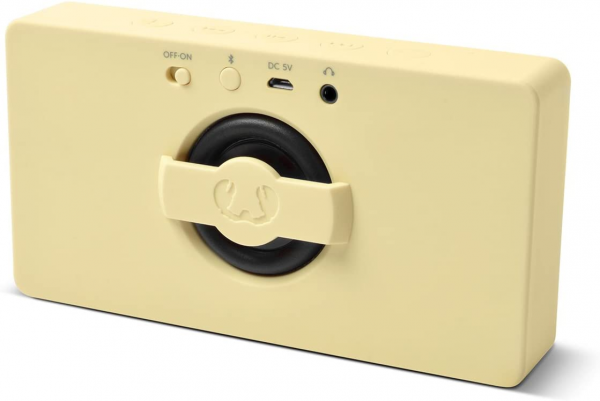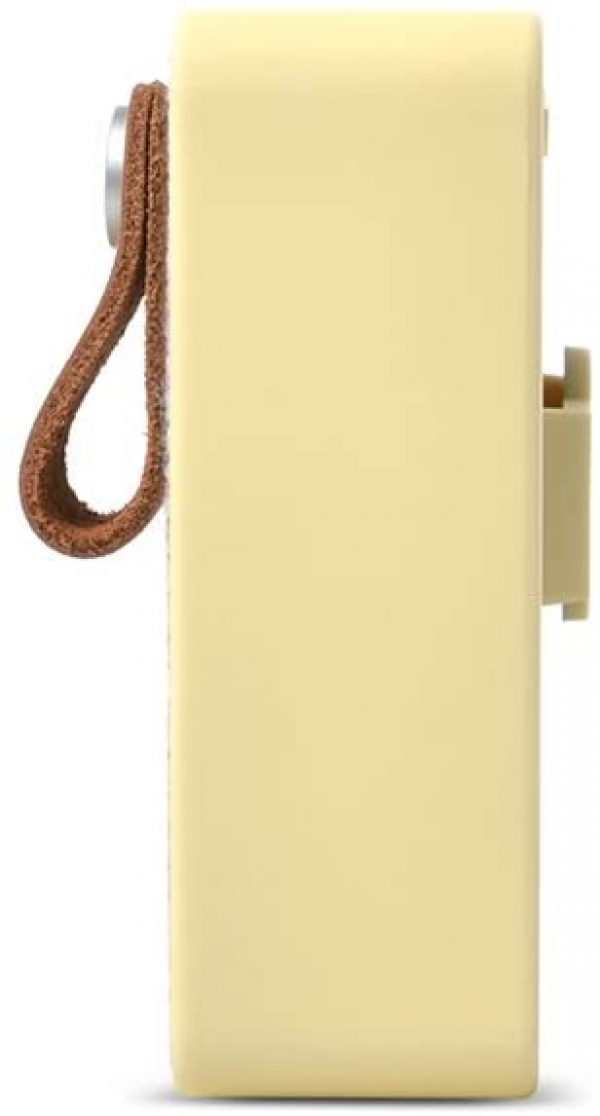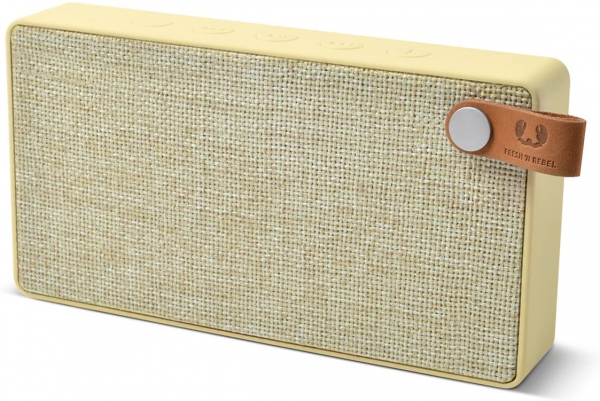Fresh 'n Rebel
Fresh 'n Rebel Rockbox Slice: between design and sound, she decided
Aprox. 25€
See specificationsSpecializing in accessories for "lifestyle" smartphones, the Dutch brand Fresh 'n Rebel also shows a certain taste for audio. It offers indeed in its catalog many references of headphones, earphones and portable speakers. In the latter category, we tested the Rockbox Brick a few months ago, which had not left us with lasting memories. It is now the turn of the Rockbox Slice to pass on our bench ... and the result is not more conclusive.
Positive points
Design.
Complete orders.
Bad points
A little short bass.
Completely disproportionate distortion.
No automatic connection to paired devices.
Microphone of the execrable hands-free kit, unusable.
Autonomy.
Our review
Ergonomics
Who says "lifestyle" think before any design worked, and on this aspect at least, the Rockbox Slice has some arguments to make. Taking up the visual language of the whole range of speakers from its manufacturer, its aesthetics is certainly not distinguished by its originality: the combination of rubbery plastic and an acoustic grid made of fabric gladly recalls what can be found by example at Libratone, Ultimate Ears , or even Cambridge Audio. Regardless, its appearance is dashing, cleverly spiced by the small leather buckle (purely decorative), and is accompanied by a quality of production quite meritorious. We could just regret that the manufacturer did not choose to make its enclosure waterproof.
With its teasing weight of 400 grams and its thickness slightly less than 3 cm, the Slice narrowly fits into our criteria to qualify as ultraportable. It can easily slip into a large jean pocket.
On the functional aspect, Fresh 'n Rebel assumes to have designed a product as simple as possible, offering no convoluted options: no dedicated mobile application, no pairing of speakers, no simultaneous connection to several sources. However, ease of use is not always there. One is annoyed in particular by the fact that the Slice is unable to connect automatically to a paired device. After each ignition of the speaker, it will therefore be necessary to make a detour via the Bluetooth menu of the source device to make the connection manually.
On the top of the speaker is an exhaustive panoply of control buttons: volume adjustment, navigation between tracks and play / pause are present. This last button is also used to accept incoming phone calls, but can also be declined by long press. Note that the little bright eccentricities that we appreciated on the Rockbox Brick (button illumination, battery level indicator) are no longer here.
If the speaker has a microphone supposed to allow its use as a hands-free kit, it is in fact unusable as its quality is properly execrable. Very insensitive, yet he manages to saturate when we speak a little too close to him. Even in a calm environment, the voice capture is incredibly deaf and distant, giving the impression to our interlocutor that we are addressing him from the next room. In noisy environments, a disastrous noise reduction is added to the table, and completes making every word perfectly unintelligible.
The manufacturer promises an autonomy of 10 hours, but in fact we did not manage to reach half of this value during our tests. This is significantly less than what we are used to seeing on this type of product today.

Audio
Finally comes the moment to make the Rockbox Slice speakers speak, and it is here that she loses any chance of convincing us: her audio performance is extremely poor.
However, the frequency response curve could be an illusion - in Bluetooth at least, since the deactivation of wired DSP is not without damage. It shows a very acceptable spectral balance, even if it is regrettable that the treble extremes are cut a little early. It is especially the rather short extension of the bass that can disappoint: it is not dishonor for an ultraportable, but given the presence of a passive bass radiator, one might have hoped that it would drop significantly below of the 140 Hz observed. Unfortunately, we can actually see in use that this radiator is completely acoustically ineffective. Even when you stick your ear to it, you can only perceive a kind of snoring concentrated on the low mids rather than the bass, and which therefore does not provide any sound basis.
But all of these considerations are only anecdotal in comparison to the overwhelming measure of distortion above. Even at low volume (the measurement was made at 79 dB SPL at 60 cm), the Rockbox Slice exhibits absolutely deplorable acoustic behavior. The distortion of the low and low mids mutilates all human voices, giving them a robotic color and very hard on the eardrums. Consequently, it does not matter that the treble frequencies are restored in a relatively honest manner, they are in any case drowned in the parasitic noises generated by this distortion. On the spectrally denser audio content, the result even manages to be less pleasant at times than the sound produced by a smartphone or tablet with the correct speakers.
The Slice reproduces stereophony, but this is perfectly insignificant, since the two speakers are literally juxtaposed to each other: the separation of the channels is imperceptible.
Latency in Bluetooth is around 165 ms, in the average of wireless speakers. The difference between sound and image is clearly noticeable on a video, but we could be satisfied with it for extra viewing.

Conclusion
No redemption for Fresh 'n Rebel, whose Rockbox Slice is not much better than Rockbox Brick. Design and compactness are not everything, and cannot excuse these far from sufficient sound performances.

Specifications

